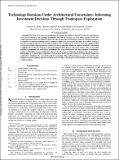| dc.contributor.author | Battat, Jonathan A. | |
| dc.contributor.author | Rudat, Alexander | |
| dc.contributor.author | Cameron, Bruce Gregory | |
| dc.contributor.author | Crawley, Edward F | |
| dc.date.accessioned | 2015-05-07T12:35:36Z | |
| dc.date.available | 2015-05-07T12:35:36Z | |
| dc.date.issued | 2014-02 | |
| dc.date.submitted | 2013-06 | |
| dc.identifier.issn | 0022-4650 | |
| dc.identifier.issn | 1533-6794 | |
| dc.identifier.uri | http://hdl.handle.net/1721.1/96922 | |
| dc.description.abstract | Although NASA has yet to choose an architecture for human spaceflight beyond Earth orbit, they must pursue near-term investment in the enabling technologies that will be required for these future systems. Given this architectural uncertainty, it is difficult to define the value proposition of technology investments. This paper proposes a method for evaluating technology across a tradespace defined by architectural decisions. Main effects analysis is taken from design of experiments to quantify the influence that a technology has on the system being considered. This analysis also identifies couplings between technologies that are mutually exclusive or mutually beneficial. This method is applied to the architecture tradespace of transportation for future human exploration at Mars with a set of possible propellant, propulsion, and aerobraking technologies. The paper demonstrates that the evaluation of technologies against an individual reference architecture is flawed when the range of architectures being pursued remains diverse. Furthermore, it is shown that comparisons between fuzzy Pareto optimal architectures and heavily dominated architectures will distort the evaluated benefit of a technology. The resulting tradespace can be structured as the sequence in which technology decisions should be made, in order of their impact on the tradespace and their coupling to other decisions. | en_US |
| dc.description.sponsorship | United States. National Aeronautics and Space Administration (Massachusetts Institute of Technology Research Grant) | en_US |
| dc.language.iso | en_US | |
| dc.publisher | American Institute of Aeronautics and Astronautics | en_US |
| dc.relation.isversionof | http://dx.doi.org/10.2514/1.a32562 | en_US |
| dc.rights | Creative Commons Attribution-Noncommercial-Share Alike | en_US |
| dc.rights.uri | http://creativecommons.org/licenses/by-nc-sa/4.0/ | en_US |
| dc.source | MIT web domain | en_US |
| dc.title | Technology Decisions Under Architectural Uncertainty: Informing Investment Decisions Through Tradespace Exploration | en_US |
| dc.type | Article | en_US |
| dc.identifier.citation | Battat, Jonathan A., Bruce Cameron, Alexander Rudat, and Edward F. Crawley. “Technology Decisions Under Architectural Uncertainty: Informing Investment Decisions Through Tradespace Exploration.” Journal of Spacecraft and Rockets 51, no. 2 (March 2014): 523–532. | en_US |
| dc.contributor.department | Massachusetts Institute of Technology. Department of Aeronautics and Astronautics | en_US |
| dc.contributor.department | Massachusetts Institute of Technology. Engineering Systems Division | en_US |
| dc.contributor.department | MIT Kavli Institute for Astrophysics and Space Research | en_US |
| dc.contributor.mitauthor | Battat, Jonathan A. | en_US |
| dc.contributor.mitauthor | Cameron, Bruce Gregory | en_US |
| dc.contributor.mitauthor | Rudat, Alexander | en_US |
| dc.contributor.mitauthor | Crawley, Edward F. | en_US |
| dc.relation.journal | Journal of Spacecraft and Rockets | en_US |
| dc.eprint.version | Author's final manuscript | en_US |
| dc.type.uri | http://purl.org/eprint/type/JournalArticle | en_US |
| eprint.status | http://purl.org/eprint/status/PeerReviewed | en_US |
| dspace.orderedauthors | Battat, Jonathan A.; Cameron, Bruce; Rudat, Alexander; Crawley, Edward F. | en_US |
| dc.identifier.orcid | https://orcid.org/0000-0003-0679-3278 | |
| mit.license | OPEN_ACCESS_POLICY | en_US |
| mit.metadata.status | Complete | |
